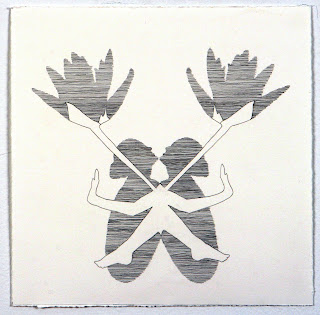Inner Landscape #5, 2008
In order to develop fluency in any aspect of our lives, we need to discover what feeds and sustains us and what doesn’t. Becoming more adept at this process is at the heart of any yoga practice. Through yoga, we develop our bodily fluency, our energetic intelligence, so that we retain the essential and release the extraneous. What serves us is retained so that it nourishes us. What doesn’t serve us is shed, released.
Through yoga, we become better acquainted with what resides at our core. From asana to breathwork and meditation, yoga offers us deep insights into our strengths and weaknesses, our abilities and our challenges. The better we know the topography of our bodies, hearts, and minds, the more we know where to place new information and ideas, where to dig, establish, and build. We can host new experiences in an optimal way, and develop fluency, a certain ease and clarity in regard to ourselves. We transform the world around us as we are transformed by it.
Paul Cézanne - Still Life with Apples c.1890
When something speaks to our sensibilities, it embeds itself within us on an emotional, psychological, or physical level. It makes us its home. Most likely it is a magnetic draw of like to like. Think of how two adjacent drops of water seem to magnetize toward each other. Now think of that apple from a Cézanne still life whose roughly sensual smudges of orange-red-brown-yellow-green make you want to merge with the painting itself…or the way that the translucent fabric of a woman’s collar in a Vermeer painting makes you hold your breath for just a moment, and in that moment the image takes up residence within you…or that sudden turn of a dancer that echoes and reverberates inside your body. Where there is affinity, the boundaries blur, open, and embrace.
Johannes Vermeer - The Lacemaker c. 1669-1670
Walt Whitman says:
I have instant conductors all over me whether I pass or stop,
They seize every object and lead it harmlessly through me.
As an artist, Whitman is a medium. He transforms and is transformed by. He is fluent. Let our bodies be a host for our experiences, allowing the best ones to embed themselves and the rest to pass through us. Then watch as we become more complex, richer for our having invited them.
Yoga is the means by which we connect, process, and transform what exists within us. As we step onto our mats, we bring with us that mix of things that is a collection of every experience we have had that day: frustrating, joyful, confusing, interesting, sad, sweet, hilarious, and indifferent. Yoga offers us the space, time, and techniques with which to process that amalgamation of experiences, and to develop fluency, lucidity, and artistry.
So try this:
Inhale. Take in every bit of information that you have received through your senses from the minute you awoke this morning - the cool tile of your bathroom floor under your feet, the fragment of a song heard through a car window, the smell of a perfect espresso or of a grimy subway stairwell, the churning crowd of bodies on your way to work, the chiseled architecture of a particular building against its blue or gray backdrop of sky… Draw these things in a steady stream toward your center.
Pause. What resides at your core? Every experience you’ve ever had is somehow lodged there or has passed through. Assimilate the new information. Soften. Let the experiences settle and merge.
Exhale. Release what doesn’t serve you. The breath draws in experience so that the external becomes internal and the internal is transformed. What you exhale is the residue. What remains is the essential. In this way, you become more adept, more fluent at understanding your own motivations, abilities, values, and goals. You become more fluent in the art of your own life.





